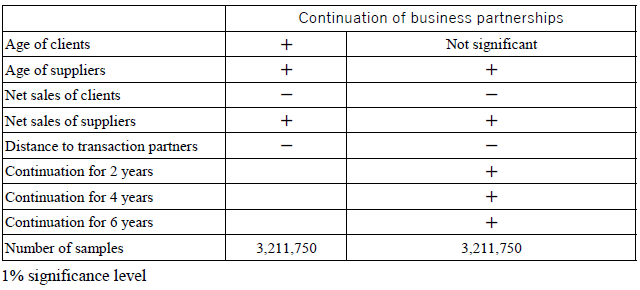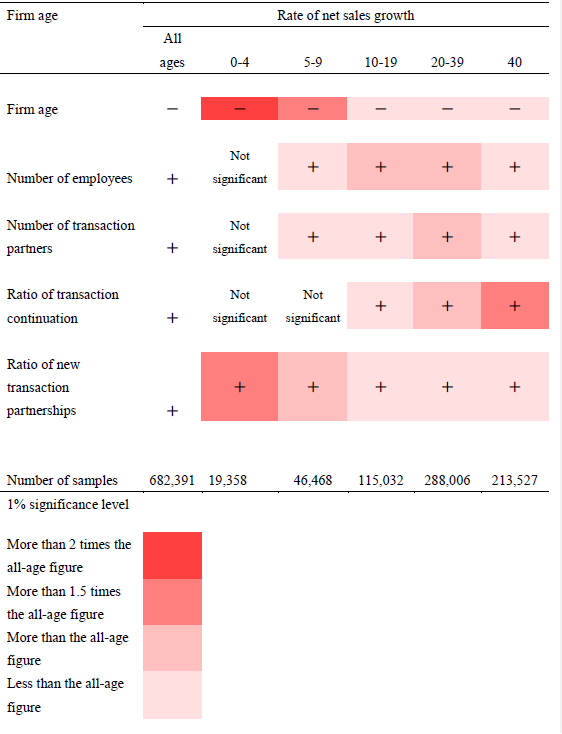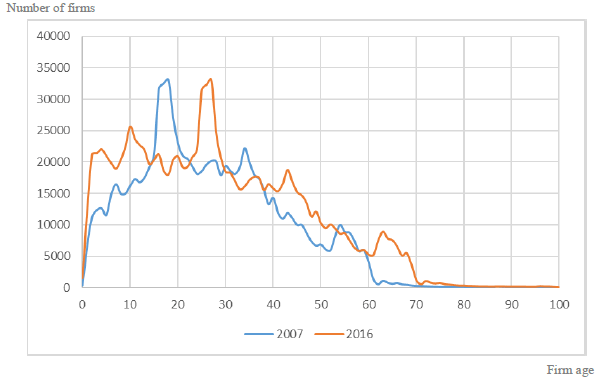| Interviewee | SAITO Yukiko (Senior Fellow, RIETI) |
|---|---|
| Issue date / NO. | Research Digest No.16 |
| Download / Links |
RIETI Senior Fellow Yukiko Saito has analyzed how inter-firm relationships (networks) evolve according to a firm lifecycle, and how such networks affect firm growth. The analysis has presented a new perspective based on inter-firm networks, as opposed to recent empirical studies' finding that firm age has a strong association with the size of subsequent growth. Saito's analysis has found that a younger firm tends to build, revise and discontinue transaction relationships more frequently than older firms do, that such inter-firm relationship stabilizes as their transaction relationships continue for an extended period of time, and that a firm age affects the association between networks and growth, with younger firms achieving growth more readily by building new transaction relationships. The findings suggest that the approach of policy support for inter-firm networks varies depending on firms' lifecycle stages.
Research motivation
—What motivated you to take on this research?
At RIETI, I am currently researching the dynamics of inter-organizational networks, examining how inter-firm relationships affect firm performance. As part of this research, I have conducted this analysis, incorporating firm age as a new factor.
I began considering firm lifecycle in the research I was involved in about 10 years ago. At the time, I was studying the historical effect of firm growth (effect of the past history of firm growth on the firm's subsequent growth), firm metabolism, and the effect of firm networks on firms exit. Then, Queen Mary University of London Assistant Professor Tatsuro Senga took an interest in these studies. About 10 years ago, the correlation between networks and firm growth history was predicted but not studied in depth. Compared to then, data concerning firm networks have been accumulated, allowing the examination of firm lifecycles in an approach incorporating the perspective of firm age. I decided to undertake this collaboration study to re-examine the association between networks and firm growth, adding the factor of firm age. Research collaboration is currently ongoing. My research partners, the abovementioned Dr. Senga and University of California, Los Angeles Lecturer Daisuke Fujii, are both theoretical research specialists. Combining theoretical research allows for even greater understanding. They are also specially appointed RIETI fellows, and I exchange ideas with them frequently.
Another motivation is the fact that I have gained access to Tokyo Shoko Research's (TSR) 10-year panel data because of my involvement in a project by the Small and Medium Enterprise Agency. TSR is a credit research company that collects detailed data from a very large number of firms. RIETI only holds intermittent TSR data for 2006, 2011, 2012, and 2014, making it unsuitable for panel analysis. However, TSR provided transaction data from 2007 to 2016 for the project of the Small and Medium Enterprise Agency, giving me an opportunity to take on this research. These data form the basis of the dataset, compiled in this research.
—Why did you focus on inter-firm networks and network dynamics?
Our RIETI research project has confirmed that inter-firm transaction networks drive firm growth from the perspective of causality. At the same time, as the government policy highlights the use of the "power of connections," it is considered important to provide policy support that encourages firm growth, using inter-firm networks. Presenting a more detailed mechanism is important in order to explore evidence-based policies. Firms grow through efforts to connect with better transaction partners and build better relationships with existing transaction partners. I believe examining the perspectives of network dynamics and firm growth will help promote greater understanding.
Inter-firm networks are an important factor not only to examine the microeconomic mechanism of firm growth, but also to consider macroeconomic implications. More recently, Acemoglu et al. found that macroeconomic fluctuations are caused through inter-firm networks. We also analyzed ripple effects following the Great East Japan Earthquake to verify them empirically. Right now, my research is based on understanding that inter-firm networks play an important role not only for macroeconomic fluctuations but also for macroeconomic growth. Existing research on Japan's "lost two decades," when the national economy stagnated, highlights the absence of correct firm metabolism, in which low-productivity firms should exit the market. Such studies did not consider the effect of mutual interactions between firms, and instead examined individual firms as completely separate operations. However, as confirmed in research on shock propagation, macroeconomic fluctuations do not represent the sum of microeconomic fluctuations. Furthermore, with confirmation that inter-firm networks promotes firm growth, I have come to the conclusion that macroeconomic growth should be examined from the networks perspective, rather than by merely adding up the growth of standalone firms.
This study first examined how inter-firm networks evolve along with firm lifecycle to identify network dynamics, and how networks would affect growth in relation to factors including firm age.
Network evolutions along with firm lifecycle and its relationship with firm growth
—What kind of research have you conducted about how an inter-firm network evolves?
With regard to the dynamics of inter-firm networks, I have focused on network stability. The perspective of how firms choose their partners in developing such networks is important, but is also very difficult as it makes it necessary to examine the mechanism of inter-firm matching. This is why I decided first to examine the relationship between firm age and network stability. More specifically, I studied how a network becomes stable as a firm becomes older. To verify this, I used data to see how a firm forms, updates, and discontinues connections (link) with suppliers and customers.
The analysis found that younger firms change such links frequently compared to older firms. More precisely, compared to older firms, younger firms tend to establish more ties with a new transaction partners, and discontinue transactions more frequently. Transaction stability that firms attain as they age could indicate that such ties accumulated between firms turn into something similar to assets for firms involved. At the same time, ceasing to build connections with new partners means the firms could be missing out on growth opportunities. From these perspectives, it is necessary to examine how inter-firm networks are built and their effect on firm growth.
As for transaction continuity, it is possible to carry out detailed analysis on how it changes according to the nature of suppliers and customers. More specifically, the ratio of transaction relationships (link) continuing into next year (survival rate) was put to regression analysis based on the characteristics of suppliers and customers. The analysis found that, as shown in Table 1, the probability of transaction relationship continuation has a positive correlation with age of suppliers as well as customers. Interestingly, the sales of suppliers and customers have a different correlation with transaction continuity. The greater the sales size of suppliers is, the higher the probability is for transaction continuation. On the other hand, the greater the sales size of customers is, the lower the probability is for transaction continuation. Customers with a larger size of sales are suspected to be rebuilding transaction relationships with new partners, rather than maintaining transactions with existing partners. Indications are that, as a firm grows in its size, it gains a greater benefit in finding better suppliers, and could therefore start spending more in searching for better suppliers.
Table 1 also shows that the more that transaction relationships continue, the more they stabilize.

—Next, can you explain about your analysis on the relationship between inter-firm networks and firm growth?
In order to examine the relationship between inter-firm networks and firm growth through firm lifecycle, firm samples were divided into five groups based on firm age, i.e. 0-4 years old, 5-9 years old, 10-19 years old, 20-39 years old, and 40+ years old. I studied how the relationship between inter-firm networks and firm growth varies between these groups, and identified differences in this relationship according to firm age (Table 2). The groups of higher firm age showed a smaller relationship between firm age and growth. The groups of lower firm age showed greater age-based differences. Such natural results were controlled before observing the relationship between inter-firm networks and firm growth. As a result, age-based differences were greater for changes in transaction partners (network dynamics) than for the number of transaction partners (network size). My observation was that for younger firms, those that aggressively build new transaction partners have a greater rate of sales growth, and that a stable transaction relationship becomes more important for older firms. These findings suggest that seeking new transaction partners is important for younger firms, and that they require policy support in this area. Note that this analysis examined only correlation, and has not discussed in-depth causality. Further analysis is required to compile more solid and specific policy suggestions. In addition to causality, the analysis must adopt additional perspectives, e.g., whether effect of relationship development differs between suppliers and customers, and what kind of transaction partners firms should seek to connect with.

—What are the new perspectives adopted in this study?
We presented new perspectives to existing studies on firm growth. With regard to decisive factors for firm growth, Gibrat examined how firm growth depends on a firm's size. There are numerous papers that examined the relationship between firm growth and firm size. Despites those, Haltiwanger et al. referred to firm age in their analysis. Haltiwanger et al. highlighted the importance of firm age, and pointed to the need to direct attention to the effect of firm age, rather than firm size, on firm growth. The study added that a government policy, aimed at creating employment, should provide assistance to younger firms instead of small- and medium-sized enterprises (SMEs). However, their study fell short of explaining the mechanism on why firm age is so important for firm growth. Our study is unique in that it incorporates the perspective of network dynamics in examining the relationship between firm growth and firm age, in order to uncover the underlying mechanism. Another uniqueness is found in the presentation of a firm age perspective in examining network dynamics.
Policy implications
—What policy implications have you obtained?
The Small and Medium Enterprise Agency project aims to identify long-term changes that will have occurred to SMEs by 2030. This study examined changes that have occurred to them over the last 10 years, and found rapid progression of aging among firms. As shown in the figure, the firm population pyramid, showing the distribution of firms according to their age, has a peak similar to the Baby Boomer peak in the normal population pyramid, shifting toward the high age category in the next 10 years. This study has confirmed that the relationship between inter-firm networks and firm growth varies according to firm age. That means that, when firm aging progresses, policy intervention must be adjusted accordingly. It is naturally important to implement policies that encourage firm metabolism to halt firm aging, but it is even more important to accept the current trend of firm aging and adopt policies that encourage firm growth in the given context.

When research advances in the future to identify what kind of partnership building will lead to firm growth, we might be able to say that firms should adopt a different type of partnership building according to their age. Then, the Small and Medium Enterprise Agency, for example, could launch a website as part of its policy to offer business matching, referring suitable potential transaction partners to firms. Yet, there has not been much research progress in this area due to the difficulty in verifying connections between individual firms from a business matching perspective. It is difficult to examine their compatibility as transaction partners for both sides of business matching. This is a research task for the future.
Future initiatives
—Finally, can you tell us about your future research?
This research was a fact-finding study on how inter-firm networks develop through the firm lifecycle, and how such networks relate to firm growth. However, no consideration was given to firms' market entry and exit in their firm lifecycle. In the future, I would like to encompass firms entering and exiting business in my study. Yet, there is still room for further deepening research on the relationship between firm age and firm growth. In addition to the perspective of what kind of business partnerships firms should be connected to, as explained earlier, we must examine, in greater detail, the perspective of building new business partnerships and deepening closer ties with existing business partners. In fact, there is data from Belgium that is actually for calculating value-added taxes, but encompasses transaction volumes of all firms broken down by business partners. This allows us to identify how firms deepen their ties with existing business partners. I wish there was such data for Japan, but that is unfortunately not the case. While it may be difficult to identify the depth of individual transactions, data such as sales value, number of customers, purchase value, and number of suppliers can be used to estimate the average depth of such transactions. I would like to examine the advantages and disadvantages of finding new business partners and continuing (deepening) transactions with existing business partners.
Furthermore, the results of this fact-finding study will be used to draw up a logical framework to deepen the understanding over individual facts. With the relationship between firm growth, inter-firm networks and firm age are beginning to be clarified, I am currently working with my joint researchers, Dr. Senga and Dr. Fujii, who specialize in theoretical research, to build a theoretical model on this matter. In considering networks, I wish to build a model that allows us to examine network stability, as studied in this research, as well as desirable business partners to network with, development of new transaction partnerships and deepening of relations with existing business partners.
The structure for building the theoretical model is already prepared. Dr. Senga studies firm dynamic model theory and simulation analysis. Incorporating the network variables, observed in this study, enables the simulation of firm growth. This not only enables gauging macroeconomic effects, but also facilitates policy simulation. Having already worked with Dr. Senga in the K supercomputer project, I have high expectations for the collaboration, which will enable various policy assessments.
Dr. Fujii studies theories that explicitly incorporate networks within the framework of economic models. Many network analyses in the economics field only deal with local networks (around individual firms). However, our project on seismic disaster propagation and Dr. Fujii's research can encompass far-reaching networks as a whole rather than local networks. For example, when examining a firm's growth factors, we can consider the impact of the indirect business partners, such as business partners of the firm's business partners. I would like to use facts obtained in our research in a way that is acceptable in terms of economic theories, so as to build a theoretical model that examines entire networks. By combining empirical research and theoretical research, I hope to achieve research of high added value both in terms of academic value and policy applications.
Profile
Yukiko Umeno Saito has been a senior fellow at the Research Institute of Economy, Trade and Industry, Japan since 2014, and was a fellow from 2012-2014. Prior to that, she was a researcher at the Fujitsu Research Institute, Japan from 2002 to 2012. She received a Ph.D. in Physics from the University of Tokyo in 2002. She was a research fellow of the Japan Society for the Promotion of Science from 1999 to 2002. Her research field is industrial organization and spatial economics. She is interested in how firms construct inter-firm relationships and how it affects a firm's performance.
Her works include: "Production Networks, Geography and Firm Performance," (with A.B. Bernard and A. Moxnes), Journal of Political Economy, forthcoming (NBER Working Paper, No.21082 (2015.4)); "Geographical Spread of Interfirm Transaction Networks and the Great East Japan Earthquake," in The Economics of Interfirm Networks, Springer Publishing, 2015.


